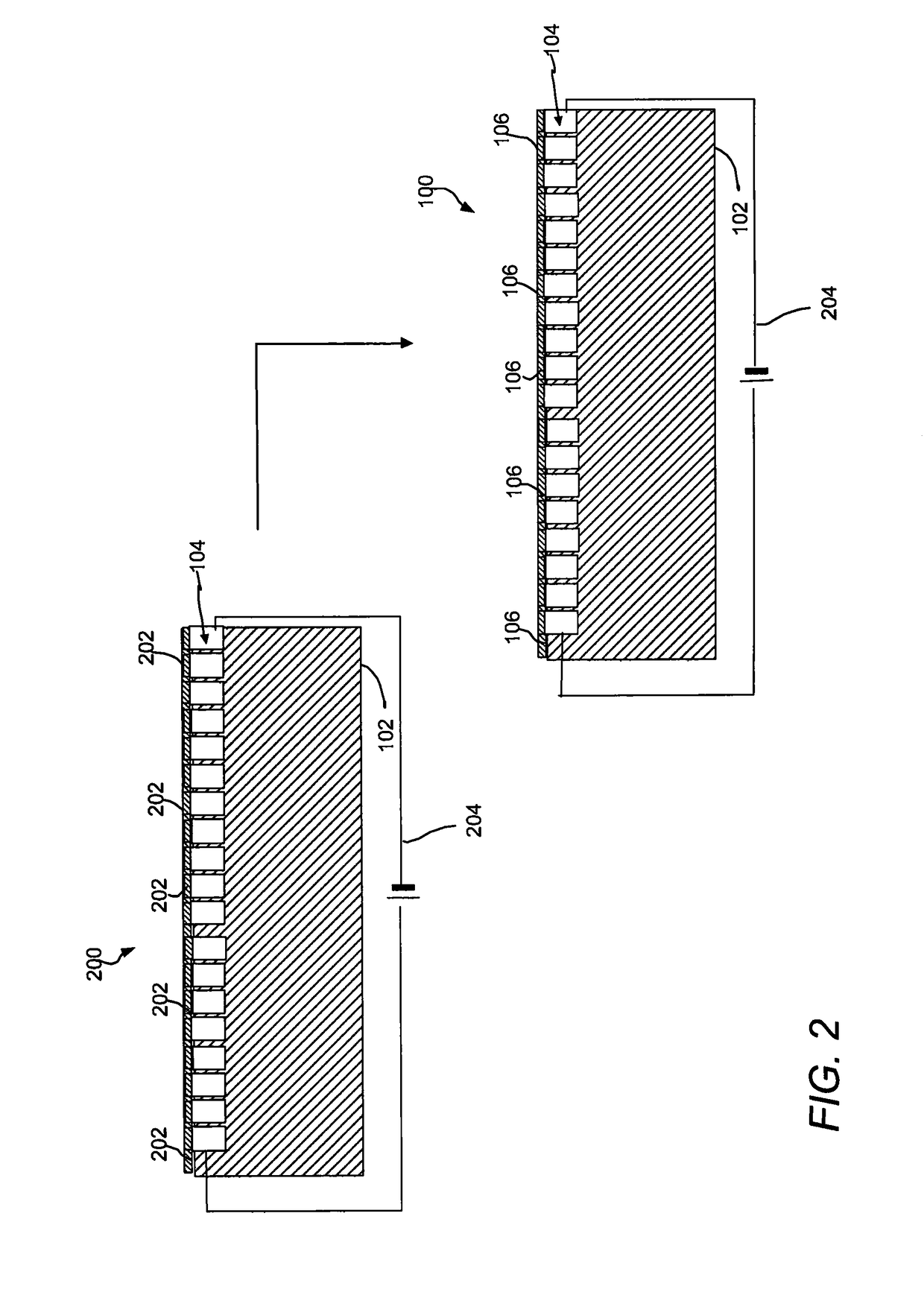Process and material for growth of adsorbed compound via nanoscale-controlled resistive heating and uses thereof
a technology of resistive heating and nanoscale, which is applied in the direction of catalyst activation/preparation, metal/metal-oxide/metal-hydroxide catalyst, synthetic resin layered products, etc., can solve the problem of material decomposition in air, and achieve the effect of reducing the number of components needed to produce nanostructured materials, reducing costs, and increasing control of nanostructur
- Summary
- Abstract
- Description
- Claims
- Application Information
AI Technical Summary
Benefits of technology
Problems solved by technology
Method used
Image
Examples
example 1
Preparation of Supported Material Containing Joule Heaters
[0103]Supported material containing joule heaters were fabricated by putting a droplet of silver paint on copper wire placed at the edge of the polycarbonate film sheets (1.6 cm×0.3 cm) containing joule heaters made by embedding sliver nanowires (Ag NW) in the surface of the film. The heaters had a resistance of about 30-35 Ω / square). The electrode dimensions were kept fixed for all the experiments. A multi-meter was used to check the resistance of the electrode. DC voltage was applied to the film heater through a copper contact at the film edge and the current and resistance were monitored.
example 2
Formation of Nanostructures on a Supported Material
[0104]A droplet of nanostructure precursor a salt solution (2-5 μL, H2PtCl6 (1.95×10−4 M), TEOS, 99%, or zinc acetate (0.01 M in water)) was deposited on the supported material prepared as described in Example 1, which was connected to the DC power supply. The droplet did not dry during the experiment. The DC voltage ranging between 0.6 V and 6 V was applied (the voltage was raised to the desired value in steps of 0.2-0.3 V) for 1 hr. Three voltages were selected (2 V, 3.6 V, and 4.8 V) and joule heating of the salt was conducted for a specific duration (5 min, 10 min, 20 min, 40 min, and 60 min) at each voltage to convert the nanostructure precursor to a nanostructure (e.g., zinc acetate liquid to zinc oxide nanostructures, chloroplatinic acid to platinum nanostructures, and tetraethyl orthosilicate to silica nanostructures). Short nanowires had a length of 10 to 20 microns and long nanowires had a length of 30 to 40 microns
example 3
Characterization of Nanostructures
[0105]The supported structures containing the nanostructures were analyzed for morphology, size, and composition using scanning electron microscopy (SEM) and energy dispersive spectroscopy (EDS) using a JSM 7800F Prime (JEOL, U.S.A.)
[0106]1. Zinc Oxide Nanostructures in Polycarbonate Polymer Matrix
[0107]Different shapes of zinc oxide nanostructures evolved (cross-sections: circular, triangular, hexagonal, pentagonal, rectangular, rhombus, etc.) as a function of joule heating voltage and duration. FIG. 11 shows includes Table 2, which lists the conditions for forming the nanostructures from zinc acetate at a 1 hour duration time period, and a schematic of the types of nanostructures formed. FIG. 12 shows the EDS of the zinc acetate precursor decomposition to zinc oxide. FIG. 13 shows different SEM images of the zinc oxide nanoparticles formed from zinc acetate at 0.6 V, 1.2 V, 1.8 V, 2.0 V, 2.4 V, 2.5 V, 3.0 V, 3.6 V, 4.2 V, 4.8 V, 5.4 V, and 6.0 V u...
PUM
| Property | Measurement | Unit |
|---|---|---|
| speed | aaaaa | aaaaa |
| speed | aaaaa | aaaaa |
| speed | aaaaa | aaaaa |
Abstract
Description
Claims
Application Information
 Login to View More
Login to View More - R&D
- Intellectual Property
- Life Sciences
- Materials
- Tech Scout
- Unparalleled Data Quality
- Higher Quality Content
- 60% Fewer Hallucinations
Browse by: Latest US Patents, China's latest patents, Technical Efficacy Thesaurus, Application Domain, Technology Topic, Popular Technical Reports.
© 2025 PatSnap. All rights reserved.Legal|Privacy policy|Modern Slavery Act Transparency Statement|Sitemap|About US| Contact US: help@patsnap.com



